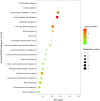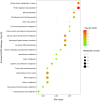Mechanism of Guilu Erxian ointment based on targeted metabolomics in intervening in vitro fertilization and embryo transfer outcome in older patients with poor ovarian response of kidney-qi deficiency type
- PMID: 36742408
- PMCID: PMC9897313
- DOI: 10.3389/fendo.2023.1045384
Mechanism of Guilu Erxian ointment based on targeted metabolomics in intervening in vitro fertilization and embryo transfer outcome in older patients with poor ovarian response of kidney-qi deficiency type
Abstract
Objective: To study the effect of Guilu Erxian ointment on the outcome of IVF-ET in older patients with poor ovarian response infertility of kidney-qi deficiency type, and to verify and analyze the mechanism of action of traditional Chinese medicine on improving older patients with poor ovarian response infertility of kidney-qi deficiency type from the perspective of metabolomics using targeted metabolomics technology, identify the related metabolic pathways, and provide metabolic biomarker basis and clinical treatment ideas for improving older patients with poor ovarian response infertility.
Methods: This study was a double-blind, randomized, placebo-controlled trial, and a total of 119 infertile patients who underwent IVF-ET at Shandong Center for Reproduction and Genetics of Integrated Traditional Chinese and Western Medicine were selected. Eighty older patients with infertility undergoing IVF were randomly divided into older treatment group and older placebo group, and another 39 young healthy women who underwent IVF-ET or ICSI due to male factors were selected as the normal control group. Flexible GnRH antagonist protocol was used for ovulation induction in all three groups, and Guilu Erxian ointment and placebo groups started taking Guilu Erxian ointment and placebo from the third day of menstruation until IVF surgery. And ultra-high performance liquid chromatography-triple quadrupole mass spectrometer (UHPLC-QTRAP MS) was used to detect metabolites in the three groups of samples.
Results: Compared with the placebo group, the number of oocytes retrieved, 2PN fertilization, high-quality embryos, total number of available embryos and estrogen on HCG day were increased in the treatment group, and the differences were statistically significant (P > 0.05), but the clinical pregnancy rate of fresh embryos and frozen embryos were not statistically significant (P > 0.05). The results of targeted metabolomics analysis showed that follicular fluid in the treatment group clustered with the normal young group and deviated from the placebo group. A total of 55 significant differential metabolites were found in the follicular fluid of older patients with poor ovarian response of kidney-qi deficiency type and patients in the normal young group, after Guilu Erxian ointment intervention, Metabolites such as L-Aspartic acid, Glycine, L-Serine, Palmitoleic Acid, Palmitelaidic acid, L-Alanine, Gamma-Linolenic acid, Alpha-Linolenic Acid, and N-acetyltryptophan were down-regulated, mainly involving amino acid metabolism and fatty acid metabolism.
Conclusion: Guilu Erxian ointment can effectively improve the clinical symptoms and IVF outcomes of older patients with poor ovarian response of kidney-qi deficiency type. There were differences in follicular fluid metabolites between older patients with poor ovarian response of kidney-qi deficiency type and normal women. L-Aspartic acid, L-Alanine, Aminoadipic acid, L-Asparagine, L-Arginine, L-Serine, Gamma- Linolenic acid, Pentadecanoic acid and Alpha-Linolenic Acid are closely related to older patients with poor ovarian response due to deficiency of kidney-qi and may be inferred as biomarkers. The mechanism of Guilu Erxian ointment intervention may be mainly through amino acid metabolism and fatty acid metabolism regulation.
Keywords: POR; advanced age and low response; kidney qi; metabolomics; targeted metabolomics.
Copyright © 2023 Ma, Song, Cao and Sun.
Conflict of interest statement
The authors declare that the research was conducted in the absence of any commercial or financial relationships that could be construed as a potential conflict of interest.
Figures











Similar articles
-
The Mechanism of Traditional Chinese Medicine Based on Semi-Targeted Metabolomics to Improve IVF Outcomes in Senile Patients.Evid Based Complement Alternat Med. 2021 Nov 10;2021:6696305. doi: 10.1155/2021/6696305. eCollection 2021. Evid Based Complement Alternat Med. 2021. PMID: 34804183 Free PMC article.
-
Efficacy and safety of Dingkun pill for female infertility patients with low prognosis undergoing in vitro fertilization-embryo transfer: study protocol for a multicenter, double-blind, randomized, placebo-controlled trial.Trials. 2020 Jun 19;21(1):550. doi: 10.1186/s13063-020-04502-z. Trials. 2020. PMID: 32560734 Free PMC article.
-
Ovulation triggering with hCG alone, GnRH agonist alone or in combination? A randomized controlled trial in advanced-age women undergoing IVF/ICSI cycles.Hum Reprod. 2022 Jul 30;37(8):1795-1805. doi: 10.1093/humrep/deac114. Hum Reprod. 2022. PMID: 35595223 Clinical Trial.
-
Guidelines for the number of embryos to transfer following in vitro fertilization No. 182, September 2006.Int J Gynaecol Obstet. 2008 Aug;102(2):203-16. doi: 10.1016/j.ijgo.2008.01.007. Int J Gynaecol Obstet. 2008. PMID: 18773532 Review.
-
Higher probability of live-birth in high, but not normal, responders after first frozen-embryo transfer in a freeze-only cycle strategy compared to fresh-embryo transfer: a meta-analysis.Hum Reprod. 2019 Mar 1;34(3):491-505. doi: 10.1093/humrep/dey388. Hum Reprod. 2019. PMID: 30689865
Cited by
-
Integrating Acupuncture and Herbal Medicine into Assisted Reproductive Technology: A Systematic Review and Meta-Analysis of East Asian Traditional Medicine.Healthcare (Basel). 2025 Jun 3;13(11):1326. doi: 10.3390/healthcare13111326. Healthcare (Basel). 2025. PMID: 40508938 Free PMC article. Review.
References
-
- Zhang A, Sun H, Yan G, Han Y, Zhao Q, Wang X. Chinmedomics: A powerful approach integrating metabolomics with serum pharmacochemistry to evaluate the efficacy of traditional Chinese medicine. Engineering (2019) 5(1):60–8. doi: 10.1016/j.eng.2018.11.008 - DOI
Publication types
MeSH terms
Substances
LinkOut - more resources
Full Text Sources
Medical

